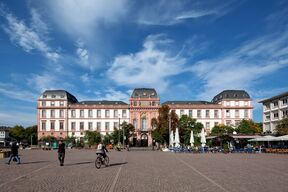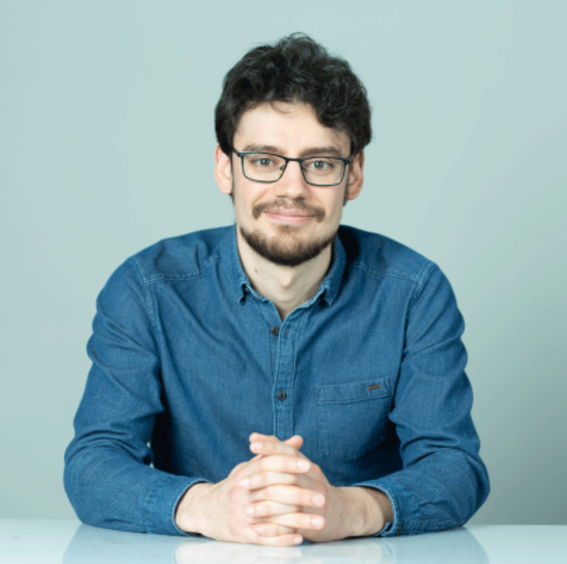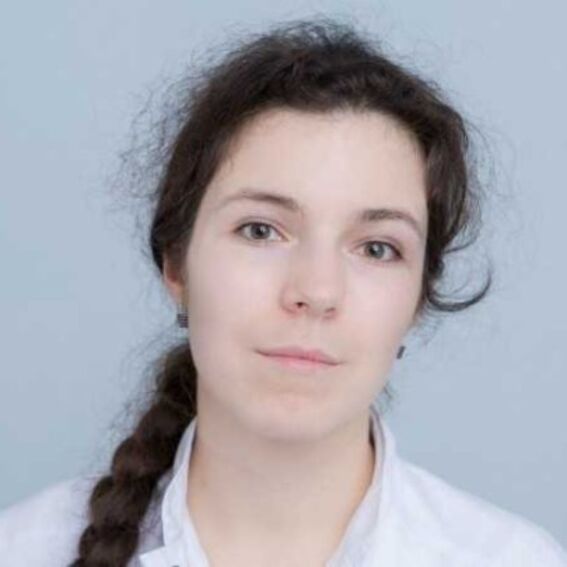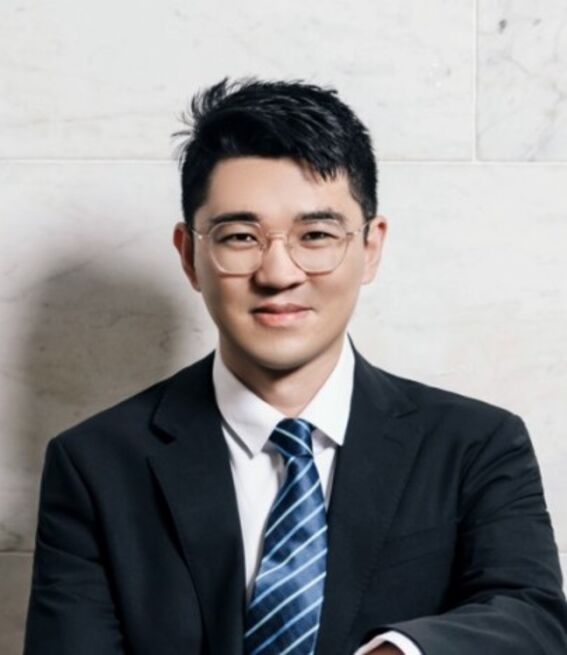Unite! University Alliance
Aalto University is a member of Unite! alliance together with eight other European universities.

The visiting professorship programme is a strategic collaboration among Unite! universities fostering academic networking and supporting the career development of early-career researchers. TU Darmstadt students also benefit from international teaching: visiting professors offer complementary courses that broaden the academic portfolio. Following a successful first round in the winter semester 2024/2025 with four visiting professors, this year’s programme welcomes eleven visiting professors, six from Aalto, who are contributing to teaching and research across seven departments at TU Darmstadt.
Learn more about the Aalto academics below.

Dr. Cuerda conducts research in the fields of nanophotonics, quantum optics, and plasmonics. His work focuses on the interaction of light and matter at the nanometer scale. Through his course “Quantum Plasmonics: From Principles to Current Trends,” he brings the latest developments in quantum materials research into physics education at the Department of Physics at TU Darmstadt.
What advantages do you see in teaching and researching at another European university?
I am very grateful for this opportunity. Initiatives like Unite! bring European universities closer and foster knowledge exchange that benefits both the host institution and the visiting professor. While real-life interactions between researchers are very important, such opportunities are usually limited to a few days, e.g., conferences or symposia. Longer stays like this allow a more genuine and deeper interaction, enabling meaningful scientific collaborations. I particularly value the freedom I have to interact with several groups at the Department of Physics, understand their lines of research in detail, and assess how I can contribute best.
We have truly embraced the interdisciplinary spirit of the Unite! alliance, as my research topics do not significantly overlap with any of the existing research lines at TUDa. The timespan of the Visiting Professorship allows me to develop a common language with the different groups and build a shared understanding across our fields, so that collaboration can grow into something substantial. This type of complementarity encourages creativity on both sides and raises the potential impact of the resulting studies, not only in the academic context but also for industry and society.
This Visiting Professorship is not only an opportunity for students to learn a topic that is not usually taught at TUDa, but also for me to independently design the course materials and reflect on the fundamentals of the field. Until now, my teaching experience has mostly followed fixed programmes in broader topics such as quantum mechanics and optics, so creating a course on my research field is both a challenge and an opportunity to grow as an instructor. The teaching experience gained here will strengthen my portfolio and be valuable when applying for an assistant professorship in Europe. I have no doubt that this position will be a crucial step in my career.
Why should students be interested in your scientific subject? What makes it exciting?
My scientific subject is plasmonics. This is a field that explores the behavior of light close to metallic nanostructures, enabling devices that guide and amplify light over very small distances, with applications in sensing, photovoltaics, optical communications, and biomedicine.
While the field itself is not new, it has recently expanded in new directions. Scientists can now design tiny plasmon-based lasers that operate regardless of the presence of defects or imperfections. The inclusion of magnetic materials is also a reality and enables an unprecedented degree of control over the capabilities of these devices. In the era of quantum applications, plasmonic systems may be coupled with single quantum emitters to enable on-chip generation and routing of single photons, and even single-photon transistors. In the presence of multiple quantum emitters, plasmonic systems also give rise to macroscopic quantum phenomena such as Bose–Einstein condensation. Both theory and experiments show rapid developments in this field.
I feel that we are on the verge of a whole new set of applications that will complement existing efforts toward novel quantum technologies. Students who enter the field at this point will have the opportunity to be part of that change and make a real-world impact.
“If I were a student today, I would…”
This is a very open statement, and I could answer it in many ways. Most honestly, I think I would be impressed by how quickly the world is changing. Professionally, the emergence of AI and quantum computing promises a major technological shift, and as a student I would want to adapt to that while still pursuing my own dreams and becoming my own person.
On a more personal level, I would also try to balance my professional ambitions with other aspects of life—friends, family, environmental and political awareness. I would take care of myself, both in my eating habits and by keeping an active lifestyle, making choices that feel healthy and responsible. It is easy to get absorbed in our thoughts or our phones, but life also happens outside of them. I would remind myself to spend time outdoors, stay active, and connect with people in person.

Dr. Nazarova works at the intersection of medical technology, signal processing, and artificial intelligence. Her research focuses on AI-supported diagnostics and neurotechnologies. Through her teaching, she helps build bridges between engineering and medicine. At TU Darmstadt she supports teaching and research in the Department of Electrical Engineering and Information Technology. The topic of her course is´Neuroscience and Artificial Intelligence in Medicine`.
What advantages do you see in teaching and researching at another European university?
For me, this visiting professorship was a wonderful opportunity to return to teaching — something I had truly missed during the years after my urgent relocation in 2022. It also allows me to design a completely new course from the ground up and to engage with colleagues from different disciplines, primarily AI and computer science. This exchange of very different perspectives is one of the most enriching aspects of working in a European academic environment.
Why should students be interested in your scientific subject? What makes it exciting?
I am noticing that many engineering students today are strongly drawn to artificial intelligence, and my course stands in a slot previously dedicated to AI. So when I told in my first lecture that we will focus on the real brain, I saw a bit of disappointment in many. But I genuinely believe that nature is the most sophisticated engineer we know. By understanding the principles of nervous system organization, we can design new technologies inspired by nature. In addition, progress in medical fields, and in neurorehabilitation in particular, is often limited because engineers, developers, and clinicians do not understand each other’s needs, language, or ways of thinking. When these groups communicate deeply and consistently, innovation becomes much richer and faster. My subject sits exactly at this intersection, and I do think this type of course is also needed for engineering students who want to create meaningful, human-centered technologies.
Which cutting points / interfaces to other faculties at TU Darmstadt exist in your area of research?
My entire course is built around interdisciplinary communication. At the moment, my closest collaborators at TUD are AI researchers and game developers, and I see many opportunities for deeper joint projects with them. I am also very interested in connecting with colleagues in robotics to explore how new, affordable robotic technologies can be better integrated into home rehabilitation. I realized that my course could also be valuable for computer science students and for those in the synthetic biology program. If I were designing it from scratch, I would definitely advocate for including it in their curricula; at the moment, they cannot formally receive credits for it.
“If I would be a student today, I would…”
I would travel much more and try to spend a semester or two at different universities and in different countries. It is an extraordinary opportunity to experience new perspectives, discover alternative ways of thinking about the same problems, and feel part of a global academic community. I have always believed that science and education should transcend borders, and especially in today’s world, genuine inclusivity, curiosity, and international collaboration among students feel like one of our last sources of hope.
In which faculty would you like to spend a day to get a taste of it? Why?
I would love to spend a day in the Department of Biology. I heard about their organoid research during the Unite! Research School in Grenoble, and it sounded fascinating. Biology and medicine remain my core scientific background, so exploring their work more closely would be very natural for me.
What else are you looking forward to in Germany?
I am a big opera fan, so I am thoroughly enjoying being close to several wonderful opera houses during my stay in Germany.

Dr. Amiri is an expert in sustainable construction, material ecology, and circular building processes. At Aalto University, he conducts research on integrating life cycle assessments into architecture and construction. His work combines ecological evaluation with innovative building practices and contributes to the development of climate-neutral building concepts. At TU Darmstadt he supports teaching and research in the Department of Civil and Environmental Engineering. The topic of his course is ‘Life Cycle Assessment for Sustainable Building’.
Why should students be interested in your scientific subject? What makes it exciting?
The way we design and build our cities has a direct influence on climate change, resource use, and the quality of daily life. Buildings last for decades, sometimes for over a century, so decisions we make today will affect many future generations. My field focuses on making construction more sustainable, for example, by using materials like engineered timber, improving building efficiency, and planning so that materials can be reused instead of thrown away. These ideas are not just theory; they are already shaping how cities and communities are being developed in many countries.
Students may find this subject exciting because it offers the chance to create visible and meaningful change. It combines technical engineering knowledge with creativity and social responsibility. It is also a very collaborative field, where engineers, architects, planners, environmental scientists, and policymakers work together. For students, this means the skills they learn can be applied directly in real projects, from designing better buildings to helping cities meet climate goals. It is a field where you can clearly see the impact of your work in the real world.
“If I would be a student today, I would…”
If I were a student today, I would try to build a broad foundation, not only in engineering but also in areas like sustainability policy, economics, and urban planning. Understanding how technical solutions connect to the “bigger picture” helps in solving complex problems. Many decisions in construction and planning are not only technical; they also involve people, budgets, regulations, and cultural values. Learning from multiple fields helps you approach challenges more confidently and creatively.
I would also try to gain international experience early, even through short exchanges, summer schools, or online collaboration projects. Experiencing different academic cultures and working methods helps you understand how other countries approach similar challenges. It also teaches flexibility, communication, and teamwork. These are skills that stay important throughout a career, no matter which direction you choose later.
What else are you looking forward to in Germany?
I am looking forward to being part of the academic and everyday life here in Germany. German universities have a strong tradition of connecting research with practice, industry, and innovation, and I am excited to participate in that environment and learn from colleagues and students. I also hope to learn the German language, even if at a beginner level because language helps to connect with people and understand local culture more deeply.
Outside the university, I am excited to explore the country. I am especially interested in visiting southern Germany and the Alps, as well as discovering natural areas and historic cities. I also have to admit that I am curious about the famous German highways with no speed limits; I am still deciding whether I should try driving fast or stay safe and slow! Maybe I will ask everyone for advice. Overall, I am looking forward to learning, exploring, and being part of the community here.

Dr. Kucner is a computer scientist and robotics researcher specializing in autonomous systems, machine learning, and collaborative robotics. He develops models for self-learning robots and intelligent control systems and is involved in several European research collaborations. At TU Darmstadt he supports teaching and research in the Department of Computer Science. The topic of his course is ´Autonomous Systems and Robotics`.
What advantages do you see in teaching and researching at another European university?
One of the key advantages is the opportunity to significantly expand one's professional network. Spending an extended period at a host university allows for the development of strong connections with colleagues and research groups. This facilitates deeper collaboration and the creation of robust, long-term partnerships. Additionally, it offers a valuable chance to engage with disciplines beyond one's own area of expertise. Such interdisciplinary exposure can inspire new approaches to existing research challenges and open possibilities for combining efforts across fields.
Why should students be interested in your scientific subject? What makes it exciting?
My research focuses on spatial human-robot interaction—specifically, how robots can operate in close proximity to humans in a way that enables both to achieve their goals without interfering with one another. To address this, I work on complementary challenges.
One is enabling robots to understand human behavioral norms. While this has traditionally been studied in the context of direct communication, my work emphasizes encoding a general understanding of acceptable human motion patterns.
This leads to the second challenge: how robots can use this understanding to plan and execute actions that respect these implicit social norms, allowing them to blend naturally into human environments.
I find this topic fascinating because it lies at the intersection of several disciplines: computer science (especially AI, including machine learning, reasoning, and planning), robotics, sociology, psychology, and architecture. This opens up exciting opportunities for interdisciplinary collaboration.
Moreover, this research introduces a new concept of human-robot interaction rooted in coexistence. As we move toward an era where robots will share our living spaces without necessarily collaborating directly with us, it is essential that they perform their tasks without disrupting our daily lives. This line of inquiry supports the development of a new generation of intelligent machines that can adapt to human environments.
In which faculty would you like to spend a day to get a taste of it? Why?
This is a challenging question. However, given the nature of my research, I would be most interested in visiting the Faculty of Human Sciences. Engaging in discussions about human behavior and how it can be modeled is particularly intriguing. Despite significant progress, we still struggle to accurately model human behavior for robotic systems, making the challenge of robot operation around humans especially complex. I believe such a visit could spark interesting research ideas and open new avenues for collaboration.

Dr. Malhi conducts research in artificial intelligence, control systems, and algorithmic transparency. Her focus is on developing explainable and ethically responsible AI applications. She is committed to promoting interdisciplinary approaches between computer science, engineering, and ethics. At TU Darmstadt she supports teaching and research in the Department of Electrical Engineering and Information Technology. The topic of her course is ´Explainable and Ethical Artificial Intelligence for Control Systems`.
What advantages do you see in teaching and researching at another European university?
Europe’s universities provide access to high-quality research infrastructures, strong interdisciplinary environments, and participation in major international projects funded through programmes such as Horizon Europe. They offer rich opportunities for collaboration, thanks to well-established networks that connect scholars across institutions and countries. In particular, I am highly motivated to work in Germany, with the strong research culture and looking forward to stronger future research and teaching collaborations out of this programme.
Why should students be interested in your scientific subject? What makes it exciting?
Students should be interested in ethical and explainable AI because it sits at the heart of how intelligent systems are shaping society today. As AI becomes embedded in engineering, healthcare, mobility, and everyday technologies, understanding how to design systems that are transparent, fair, and accountable is essential for responsible innovation. What makes this field exciting is that it combines cutting-edge technical challenges with real societal impact: students get to work on algorithms and models while also addressing questions about trust, safety, and human values. It empowers future engineers not only to build powerful AI systems, but to ensure those systems are understood, reliable, and beneficial for everyone.
Which cutting points / interfaces to other faculties exist in your area of research?
My research is deeply intertwined with the social sciences, allowing me to examine the societal impacts, perceptions, and acceptance of AI technologies. Smart cities and smart buildings play a central role in my work, providing real-world data and practical use cases that ground my research in everyday technological environments. As a result, my field naturally connects to multiple disciplines—from computer science and engineering to sociology, psychology, and urban studies—making it a rich and multidimensional area of study.
“If I would be a student today, I would…”
I would pursue Erasmus semester exchanges because I did not have this opportunity during my own studies, and I am eager to experience it now. Engaging in such exchanges would allow me to grow personally and professionally while gaining exposure to different cultures, academic environments, and curricula.
In which faculty would you like to spend a day to get a taste of it? Why?
I would choose to spend a day in the Tourism Department because I love traveling, and this field aligns closely with my personal interests. It would give me the opportunity to learn more about different cultures, cuisines, and practical travel insights while also understanding how tourism is studied from an academic perspective.
What else are you looking forward to in Germany?
I am looking forward to visiting Christmas markets in Germany and exploring traditional German cuisine. I am also eager to immerse myself in the culture and experience the country more closely.

Dr. Li is an engineering scientist specializing in energy systems, hydrogen technologies, and energy storage. His research focuses on sustainable solutions in the energy sector. He brings valuable expertise to teaching on green energy infrastructure and storage technologies. At TU Darmstadt he supports teaching and research in the Department of Electrical Engineering and Information Technology. The topic of his course is ´Elements of Hydrogen Systems and Storage`.
What advantages do you see in teaching and researching at another European university?
I see important advantages because Europe offers a uniquely collaborative academic environment with strong traditions of interdisciplinary research and open knowledge exchange. For my field, multi-energy systems with hydrogen integration, Europe provides advanced infrastructures such as smart grids, hydrogen value chains, AI methods, and large-scale renewable projects that allow for impactful research.
Furthermore, the cultural diversity and close geographical ties of European universities facilitate more opportunities for joint supervision of students, EU-wide funding applications, and cross-border pilot projects. For me, being part of Unite! means not only teaching and mentoring students in Finland and Germany, but also co-developing curricula and research that support Europe’s green transition and carbon neutrality targets.
In which faculty you would like to spend a day to get a taste of it? Why?
I would like to spend a day in the Research Field Energy and Environment (E+E), specifically within the Integrated Energy Systems profile topic at TU Darmstadt. This area focuses on linking electricity, heat, and mobility to ensure a sustainable and climate-neutral energy supply, even under volatile demand conditions. It is almost the same as my research on the optimal planning and operation of multi-energy systems with hydrogen integration, AI-driven optimisation, and resilience enhancement.
By joining activities in this faculty, I would be able to interact with experts who are developing intelligent energy system concepts, cross-sectoral coordination strategies, and policy frameworks. This exposure would allow me to align my AI and optimisation methodologies with TU Darmstadt’s interdisciplinary strengths in energy system integration and to explore opportunities for joint research on topics such as sector coupling, energy storage, and resilient operation of hydrogen-based systems.
Which cutting points/interfaces to other faculties exist in your area of research?
My research naturally interfaces with many faculties beyond electrical engineering. For example:
Besides, I see strong opportunities for joint work across these interfaces, for example, combining physics-informed AI from computer science with energy modelling in engineering, and then analysing economic viability and policy impacts with social sciences. This kind of interdisciplinarity is essential to obtain solutions that are technically sound, economically feasible, and societally accepted.

Aalto University is a member of Unite! alliance together with eight other European universities.



